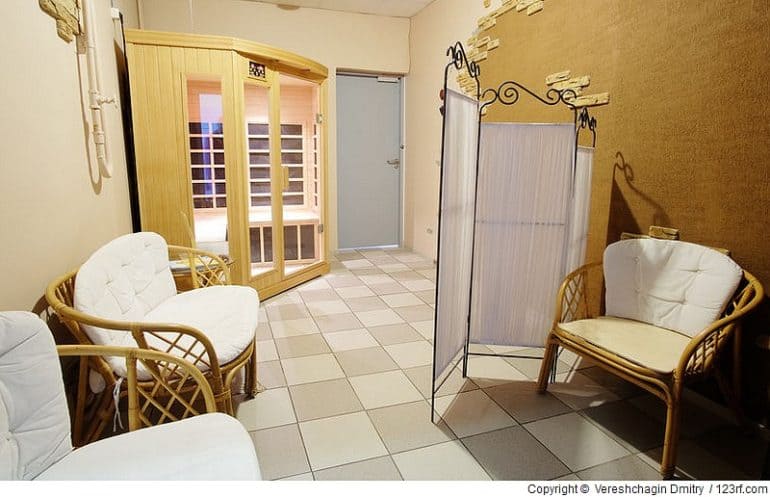Suitable locations for an infrared cabin
The right choice of location will ensure the longevity of an infrared cabin, moreover, it will be possible to fully exploit the ultimate effect throughout its lifetime. One of the basic requirements is that such a sauna cabin should be placed only where a normal room temperature usually prevails.
You should also still pay attention to this!
In addition, the cabin requires electricity, so it is imperative that there is a standard power outlet nearby. Power cord extensions that may still run through multiple rooms must also be avoided. However, water or power connections as for a conventional sauna are not required. There are no restrictions with regard to the choice of location with the floor condition, no matter whether on parquet flooring, tiles or carpet, each of these bases is basically suitable as an installation site.
Infrared cabins in the wet area regularly aerate after use
Ideal locations are in the wellness area or in the bathroom, provided that this has an appropriate size. Because hygiene and wellness can be combined well in wet areas, but also in fitness rooms. The shower is usually located in the immediate vicinity, and these rooms are also regularly heated. However, it is important to make sure that moisture does not build up, so regular airing is required after use. The wood of the infrared cabin will not be damaged if it is ventilated after each use.
Place of installation in the living and sleeping area
Also, sleep or living areas are suitable in principle as location for an infrared cab. Particularly problem-free this is then always possible, if study, guest room or living room exhibit an appropriate size. In many cases, the winter garden is also chosen as an installation site, because this is suitable in many ways as a wellness oasis, if heated accordingly. Together with a small beverage bar or deck chairs, the winter garden becomes then in the twinkling of an eye a gladly visited Wellness oasis. However, the way to the shower should not be quite so far away, because after the pleasant warm-up phase, longer walks through cool rooms can be perceived as unpleasant.
Unsuitable cabin locations for the infrared sauna
In many cases, the popular cabins are still placed in locations that are simply not suitable. Cold basement rooms or those that can only be heated minimally or not at all should be left out of the choice of location. If the outside temperature is too cold, the negative effects on the inside temperature of a cabin with infrared light should not be underestimated, aside from the increased electricity and energy consumption.
Increased energy consumption with unsuitable choice of location
The wood of a cabin has little insulating effect, and the glass acts as a cold bridge to the inside of the cabin. An insulation layer, which protects against cold outside air, is therefore not present. With such a wrong choice of location, it takes much longer to reach a really comfortable temperature inside a cabin. In addition, it should be remembered that after a session, the ambient temperature is perceived as even colder. Sensitive people can then even react with an increased tendency to infection, and the comforting warm wave effect is quickly gone.
All external areas as setting up places are likewise not suitable
If the infrared cabin is to be set up nevertheless in the cellar, then a humidity measurement can be made before. Because damp cellar areas are considered as conceivably unsuitable for the location choice. Particularly in older houses, the cellars are often damp, without this being immediately noticeable.
If the cabin is improperly located, warranty is no longer given
But the moisture often sits deep in the floors or in the masonry and is unfortunately capable of permanently damaging the cabin wood to such an extent that the cabin even becomes unusable over time. Comparable with pieces of furniture or cabinets made of wood, which also do not survive longer storage periods in damp rooms without damage, so it is also with infrared cabins. Their wood becomes brittle and fragile due to moisture, and is then no longer usable as cabin wood.
Infrared cabins are designed for indoor use
Infrared cabins are designed for indoor use. In the summer house or in outdoor areas these should not be set up, therefore, even at short notice. Because these rooms can not be tempered appropriately as a rule, and also here humidity and could damage the cabin wood in such a way that soon a use will no longer be possible.

